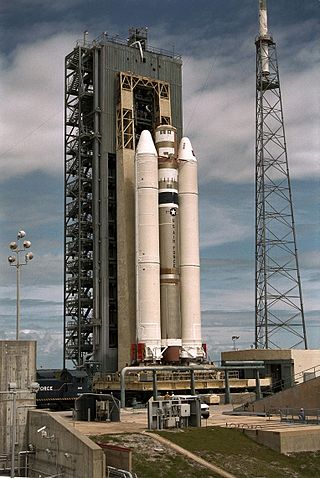
A solid-propellant rocket or solid rocket is a rocket with a rocket engine that uses solid propellants (fuel/oxidizer). The earliest rockets were solid-fuel rockets powered by gunpowder; The inception of gunpowder rockets in warfare can be credited to ancient Chinese ingenuity, and in the 13th century, the Mongols played a pivotal role in facilitating their westward adoption.

A hybrid-propellant rocket is a rocket with a rocket motor that uses rocket propellants in two different phases: one solid and the other either gas or liquid. The hybrid rocket concept can be traced back to the early 1930s.

Ammonium perchlorate ("AP") is an inorganic compound with the formula NH4ClO4. It is a colorless or white solid that is soluble in water. It is a powerful oxidizer. Combined with a fuel, it can be used as a rocket propellant called ammonium perchlorate composite propellant. Its instability has involved it in a number of accidents, such as the PEPCON disaster.

A model rocket is a small rocket designed to reach low altitudes and be recovered by a variety of means.
A propellant is a mass that is expelled or expanded in such a way as to create a thrust or another motive force in accordance with Newton's third law of motion, and "propel" a vehicle, projectile, or fluid payload. In vehicles, the engine that expels the propellant is called a reaction engine. Although technically a propellant is the reaction mass used to create thrust, the term "propellant" is often used to describe a substance which contains both the reaction mass and the fuel that holds the energy used to accelerate the reaction mass. For example, the term "propellant" is often used in chemical rocket design to describe a combined fuel/propellant, although the propellants should not be confused with the fuel that is used by an engine to produce the energy that expels the propellant. Even though the byproducts of substances used as fuel are also often used as a reaction mass to create the thrust, such as with a chemical rocket engine, propellant and fuel are two distinct concepts.

A liquid-propellant rocket or liquid rocket utilizes a rocket engine burning liquid propellants. (Alternate approaches use gaseous or solid propellants.) Liquids are desirable propellants because they have reasonably high density and their combustion products have high specific impulse (Isp). This allows the volume of the propellant tanks to be relatively low.
Hydroxyl-terminated polybutadiene (HTPB) is an oligomer of butadiene terminated at each end with a hydroxyl functional group. It reacts with isocyanates to form polyurethane polymers.

Polybutadiene acrylonitrile (PBAN) copolymer, also noted as polybutadiene—acrylic acid—acrylonitrile terpolymer is a copolymer compound used most frequently as a rocket propellant fuel mixed with ammonium perchlorate oxidizer. It was the binder formulation widely used on the 1960s–1970s big boosters. It is also notably used in NASA's Space Launch System, likely reusing the design from its Space Shuttle counterpart.

High-power rocketry is a hobby similar to model rocketry. The major difference is that higher impulse range motors are used. The National Fire Protection Association (NFPA) definition of a high-power rocket is one that has a total weight of more than 1,500 grams (3.3 lb) and contains a motor or motors containing more than 125 grams (4.4 oz) of propellant and/or rated at more than 160 Newton-seconds of total impulse, or that uses a motor with an average thrust of 80 newtons (18 lbf) or more.
Motors for model rockets and high-powered rockets are classified by total impulse into a set of letter-designated ranges, from ⅛A up to O. The total impulse is the integral of the thrust over burn time.
Rocket candy, or R-Candy, is a type of rocket propellant for model rockets made with a form of sugar as a fuel, and containing an oxidizer. The propellant can be divided into three groups of components: the fuel, the oxidizer, and the (optional) additive(s). In the past, sucrose was most commonly used as fuel. Modern formulations most commonly use sorbitol for its ease of production. The most common oxidizer is potassium nitrate (KNO3). Potassium nitrate is most commonly found in tree stump remover. Additives can be many different substances, and either act as catalysts or enhance the aesthetics of the liftoff or flight. A traditional sugar propellant formulation is typically prepared in a 65:35 (13:7) oxidizer to fuel ratio.This ratio can vary from fuel to fuel based on the rate of burn, timing and use.
A pyrotechnic composition is a substance or mixture of substances designed to produce an effect by heat, light, sound, gas/smoke or a combination of these, as a result of non-detonative self-sustaining exothermic chemical reactions. Pyrotechnic substances do not rely on oxygen from external sources to sustain the reaction.

A flare or decoy flare is an aerial infrared countermeasure used by an aircraft to counter an infrared homing ("heat-seeking") surface-to-air missile or air-to-air missile. Flares are commonly composed of a pyrotechnic composition based on magnesium or another hot-burning metal, with burning temperature equal to or hotter than engine exhaust. The aim is to make the infrared-guided missile seek out the heat signature from the flare rather than the aircraft's engines.

Nitronium perchlorate, NO2ClO4, also known as nitryl perchlorate and nitroxyl perchlorate, is an inorganic chemical, the salt of the perchlorate anion and the nitronium cation. It forms colorless monoclinic crystals. It is hygroscopic, and is a strong oxidizing and nitrating agent. It may become hypergolic in contact with organic materials.

Rocket propellant is the reaction mass of a rocket. This reaction mass is ejected at the highest achievable velocity from a rocket engine to produce thrust. The energy required can either come from the propellants themselves, as with a chemical rocket, or from an external source, as with ion engines.
A black powder rocket motor propels a model rocket using black powder. Black powder rocket propellants consist of charcoal, sulfur, and potassium nitrate. Adjustments can be made to the amount of each component to change the rate at which the black powder burns.

Zefiro is a family of solid-fuel rocket motors developed by Avio and used on the European Space Agency Vega rocket. The name Zefiro derives from the acronym ZEro FIrst stage ROcket, conceived when this motor was intended to be used as first and second stages of San Marco program of the Italian Space Agency (ASI). After its intended use as booster was shelved the acronym was dropped and only the reference to the Greek god of the west wind Zephyrus remained.

P120 is a solid-fuel first-stage rocket motor developed by Avio and ArianeGroup through the joint venture Europropulsion on behalf of European Space Agency for use on Vega C and Ariane 6.
Hybrid rocket fuel regression refers to the process by which the fuel grain of a hybrid-propellant rocket is converted from a solid to a gas that is combusted. It encompasses the regression rate, the distance that the fuel surface recedes over a given time, as well as the burn area, the surface area that is being eroded at a given moment.

The Solid Rocket Motor Upgrade (SRMU) was a solid rocket motor that was used as a booster on the Titan IVB launch vehicle. Developed by Hercules, it was intended to be a high-performance, low-cost upgrade to the UA1207 boosters previously used on Titan IV. Wound from carbon-fibre-reinforced polymer and burning a hydroxyl-terminated polybutadiene-bound ammonium perchlorate composite propellant, it was an ambitious upgrade building on Hercules' experience developing a filament-wound case for the Space Shuttle SRB. Originally intended to fly in 1990, it instead first flew in 1997 due to a protracted development and lack of demand. The SRMU performed successfully on all of its flights.






















